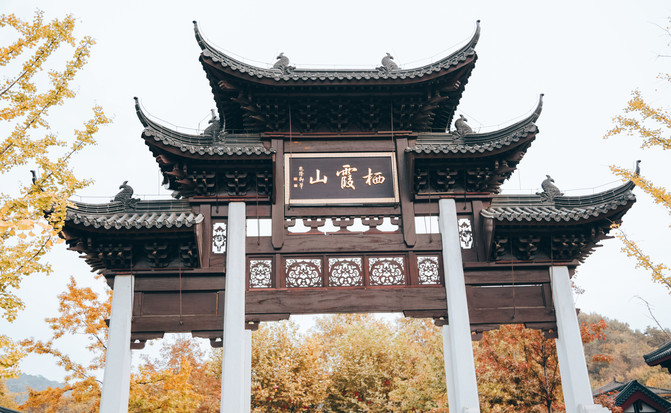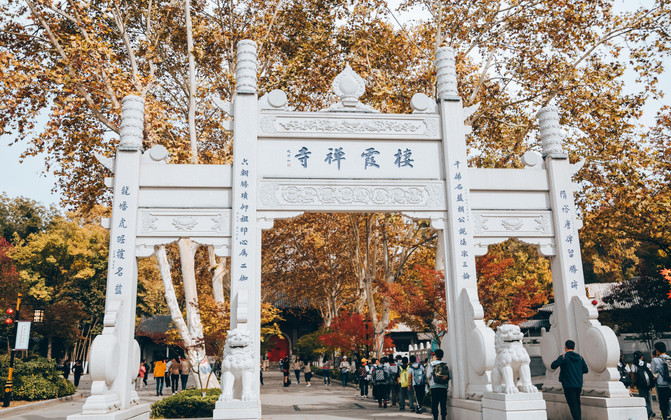Jinling in late autumn| Go to Qixia Mountain and enjoy a touch of red in the autumn day

In late autumn, Nanjing becomes as beautiful as Jinling.
The ginkgo leaves turn yellow and the maple leaves turn red, and this has become the most beautiful time in the world.

The autumn temperature in Nanjing has been relatively comfortable this year. Although it has entered November, the maximum temperature can still be maintained at around 20 degrees, so you won't feel the cold.
Qixia Temple is a tourist attraction in Qixia Mountain and a tourist attraction that must not be missed when visiting here. Generally speaking, going to Qixia Mountain in late autumn is mainly to admire red leaves, but the ancient temples and incense of Qixia Temple are also worth taking a slow step and tasting carefully.

Qixia Temple is located at the western foot of the middle peak of Qixia Mountain. It is surrounded by mountains on three sides and faces the Yangtze River in the north. It is now one of the four famous temples in China, so every year there are extraordinary believers and laymen here. Every year, there are also many Buddhist activities here. Promote Buddhism and Zen culture here.

The ginkgo trees around Qixia Zen Temple have turned yellow and the maple leaves have turned red. Together, it is indeed a very Zen picture.
The temple buildings are antique and carry the beauty of traditional Chinese architecture.

The leaves of the sycamore tree are all yellow, and the wind blows and leaves fall. The temple gate here is open to everyone, and anyone can be a member of the temple. The ancient Qixia Temple was the birthplace of the "Three Lun sects" of Buddhism. During the Northern and Southern Dynasties, it was once the center of Buddhism in China and its influence was very far-reaching. Even today, it is still of great significance to Buddhist culture.


Shushan Qixia Temple is an ancient temple in the Southern Dynasties. It was originally called Qixia Jingshe. It was named Shushan because the mountains had many medicinal plants that could be cultivated. Therefore, the name Sheshan is still retained today.
The red color of the temple gate looks very beautiful in the mottled sunshine, and the woman in white is slowly pacing in front of the temple gate. This picture is very beautiful.

Qixia Temple was built in the seventh year of Yongming in the Southern Qi Dynasty, in 489 AD. It was once famous as Jiming Temple and Dingshan Temple during the Southern Dynasties. During the Tang Dynasty, it was the heyday of our country's Buddhist culture. It was called Gongde Temple. Due to its huge scale, it was called the Four Great Jungles in the world together with Lingyan Temple in Changqing, Shandong, Yuquan Temple in Dangyang, Hubei, and Guoqing Temple in Tiantai, Zhejiang.

Nowadays, Qixia Temple also has the Qixia Mountain Branch of the Chinese Buddhist Academy. Every year, there are some Zen activities here, which can make people eat fasting and purify their hearts. For those who don't have to decide for a long time, it's good to come to Qixia Temple to experience it for a few days, experience the life here, and eat fasting and pray every day.

What is protected here is the Ming Zheng Jun Monument, which began in the third year of the Tang Dynasty and was erected by Emperor Gaozong Li Zhi. The four characters "Ming Zheng Jun Stele" were written by Tang Dynasty calligrapher Wang Zhijing. The inscription was drafted by Li Zhi, Emperor Gaozong of the Tang Dynasty. The word "Qixia" is engraved on the underside of the stele. It is said that it is written by Li Zhi.
Now that this place is well protected, we can only look from afar.

When the leaves are red, they are projected on the ancient architecture, with mottled patterns. This Zen autumn Qixia Temple is surrounded and crowded by red maples all over the mountains and fields.

This place has an important position in the history of Buddhism in our country, so it is famous. It has experienced war and now has become a national key Buddhist temple in Han areas.

The main hall is large in scale and very atmospheric. The incense here is very strong, and many pilgrims come to offer incense every day. The overall building rises layer by layer according to the mountains, and the layout is neat and beautiful.

Walking into the temple, you can see some perspectives that you can't see on weekdays.
In an all-wooden house, the trees, eaves, and feet through the doors and windows are all displayed in front of us.

Pushing open the window, the scenery outside the window is unique. When the trees are slightly yellow, with black tiles and red walls, time seems to have gone back a hundred years here.

The windows in the house are bright and clean, and through the light, plants grow vigorously.
This is the place where monks and workers work, and this is the cultural restoration site of Qixia Ancient Temple. There are many ancient books hidden in the Sutra Pavilion of Qixia Temple, but due to the past craftsmanship and the long time, they have become somewhat damaged. Their daily job is to repair the damaged ancient books here.

There are eleven meticulous and long processes to repair ancient books. These scriptures have various damages, large and small, and can only be repaired slowly manually. The master here said that their generation probably couldn't finish these thousands of ancient books.


We can also experience it firsthand. These processes may not seem difficult, but it is still difficult to repair small holes one by one, make a little imprint and then make it almost impossible to see the seams after repairing.
In some complex places, it may take an afternoon to repair a small hole. It is no wonder people say that restoring ancient books is the most self-cultivating thing. After all, you need to be able to endure loneliness and be very meticulous.

The restored scriptures still need to be flattened and dried before binding, and every step cannot be omitted. This book has been restored and looks relatively perfect in the sun.

After binding, these restored scriptures can be turned into books for people to read and can be passed on to the next generation or even beyond.

You can also experience woodblock printing here, where you brush the God of Wealth. Brush ink and put paper on ourselves, and when we uncovered it, we couldn't help but say "wow". Handmade paper is very valuable, and this self-printed "God of Wealth" naturally needs to be invited home to preserve it.

Qixia Mountain, known in ancient times as Shashan, is known as "the No. 1 Mingxiu Mountain in Jinling". "Qixia Jingshe" was built in the mountains during the Southern Dynasties, hence the name.

Qixia Mountain is not high, and its highest peak is only 286 meters. However, there are many scenic spots in the scenic area. It was listed as one of the "Forty-Eight Scenery of Jinling" in the Ming Dynasty. It has always been known as "a Qixia Mountain, half of the history of Jinling".

At present, there are more than 80 historical monuments and sites in Qixia Mountain, which gathers a lot of cultures, including religious culture, imperial culture, folk culture, tea culture, etc.

However, if we want to talk about the time when Qixia Mountain attracts most tourists, we still have to count autumn.
In Nanjing, there has always been a saying,"Travel in Qixia in autumn, travel in the ox's head in spring." For students in Nanjing, these two places are generally the ones that go to most frequently during their school Spring and Autumn tours.

Generally speaking, the earliest prelude to autumn begins with the falling of sycamore leaves.
Now it is late autumn, and for the sycamore tree, the leaves have already been exhausted. Therefore, the grass here is covered with a thick layer of sycamore leaves, and there is a rustling sound when stepping on it.


There are many such empty roads on Qixia Mountain, with dense trees and rich tree species. In autumn, there are red, yellow and green here, all kinds of colors, colorful and beautiful.
In the afternoon, when light shone through the thick leaves, the leaves falling with the wind seemed to be performing the final dance with all their strength.
This is the best place to take photos.


The beautiful woman wears very suitable clothes and takes a stroll on the road.
Wearing white clothes perfectly matches the colors, it is as beautiful as a painting.


Qixia Mountain is known as one of the four major maple attractions in China, as famous as Xiangshan Mountain in Beijing, Yuelu Mountain in Changsha, and Tianping Mountain in Suzhou. In late autumn, many tourists will definitely come here just to appreciate the red rhyme all over the mountains and plains, enjoying the last touch of color in autumn time.


There are many types of red leaves in Qixia, especially Liquidambar, including red maple, chicken claw maple, triangular maple, feather maple, beech tree, pistachia, etc. In late autumn, the mountains are all red here, just like sunset, which is spectacular.
Qixia has three peaks, surrounded by mountains on three sides and facing the Yangtze River in the north. It has a long view and excellent view.

There is currently a viewing building on Qixia Mountain, where you can see the surrounding scenery when you climb high. If the weather is clear, you can see the scene of Nanjing's Urban area from a distance.

You can see the wide Yangtze River on the other side, and the river is very busy with boats coming and going.

Of course, the best side is still the side of viewing the mountain. The trees in the mountains are dense and all colors appear.


The red leaves under the sun are shining with light and shine brightly in the sun. Generally speaking, when we enter November every year, the prelude to appreciating the maple begins, but the best time to admire the maple is from mid-November to early December. After the weather is cold, red leaves appear, and when you come at that time, the photo effect is also the best.


It feels best to have water, courtyard, beautiful women and red maple.
Generally speaking, climbing mountains and enjoying autumn cannot be without the presence of water. After all, with water, you will have agility and will bring people some different feelings.
This can be said to be a good place to take private photos.


There are many small paths in the mountains, and the Zen meaning is deep.
Because Qixia Mountain is extremely rich in geological connotations and there are many fossils of ancient organisms, it is the place where many geological names are named. Therefore, it is called the "Natural Geology Museum" and "Geoscience Textbook" by experts.

Hongye Valley is a very famous attraction in Qixia Mountain. Generally speaking, the first place tourists visit when they come here is here.
When you walk here, you can see two red-like maple trees, which are even more vivid under the blue sky.

These fiery red maple forests are as bright as red and as warm as red. Walk into the Maple Leaf Forest and enjoy the wonderful times that belong to them alone.
Previous Article:In the demeanor of a lion king in Jinling, you can see Jiangnan
Next Article:Nanjing People Look at Nanjing--Meeting Beautiful Things in Jinchuang Book City
